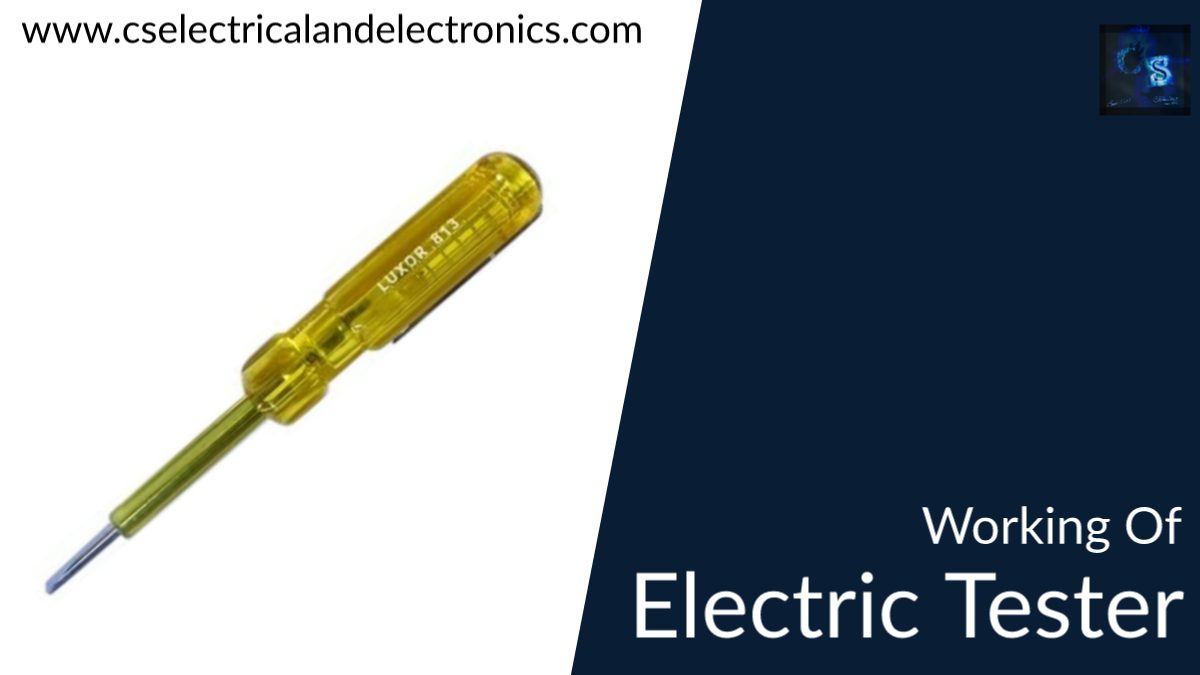Working Of Electric Tester, Will It Work On DC Supply?
Hello Guys, welcome back to my blog. In this article, I will discuss the working of the electric tester, will it works on dc supply, the circuit diagram explanation of the electric tester, and the components used in the electric tester.
If you have any electrical, electronics, and computer science doubts, then ask questions. You can also catch me on Instagram – CS Electrical & Electronics.
Also, read:
- What Is HVIL, High Voltage Interlock, Working, Purpose Of Using
- Battery Management Systems Using Artificial Intelligence
- Top 12 Latest Technologies In The Power System That Will Change Future
Working Of Electric Tester
A Tester is like a protective device for all electricians or electrical engineers, it will help electricians in many ways like checking the current in the wire before doing work with the wire. The tester is used to check only supply in the line.
Nowadays, every electrician uses an electrical tester to avoid electrical shock. The cost of the electrical tester is from 10 to 50 rupees it depends upon the company. I suggest you all take tap-aria testers because it is very safe and the best quality of tester. Nowadays all electricians use taparia tester.
How does Tester Works?
The tester mainly consists of six parts :
- 01. Metallic Rod
- 02. Resistance
- 03. Neon Lamp
- 04. Spring
- 05. Metallic Touch screw
- 06. Insulated Body
Guys these are the parts of an electrical tester, now I will discuss step by step all the parts.
01. Metallic Rod – Metallic rod is used to make contact with the live wire. To check the supply in a socket the metallic rod is inserted into a socket to check the supply. The metallic rod then gives supply to the neon bulb.
02. Resistance – The purpose of resistance is to limit the current and give it to the neon bulb. The value of resistance in the tester is one megaohm and in some cases, it varies but not more than two megaohms. The resistor is connected in series with the neon bulb.
03. Neon Lamp – The main purpose of the neon bulb is to glow and show whether the supply is there or not. The neon bulb glows when it gets 80 volts supply from the resistor.
04. Spring – It is used to make strong contact between all the parts of the tester. Without spring there will not be any strong contact between neon bulb and resistor, between resistor and resistor and metallic rod.
05. Metallic Touch Screw – From the metallic touch screw neon bulb will get a return path because while checking the supply we will keep our finger on the metallic screw.
06. Insulated Body – Without the insulated body, we can’t check the supply in the line. Insulation of the body is again a safety for electricians.
When we insert the tester into a socket or make contact with the live wire of 230 volts then the supply will go to the resistor which will drop 80 volts supply to the neon bulb, if the neon bulb gets 80 volts supply and gets a return path from human body then the neon bulb will glow. The only thing is neon bulb needs 80 volts to glow with a return path.
Will Tester Works On DC Supply
Yes, the tester will work on direct current. Normally to check dc supply using the tester, we will make contact with a 12 v battery or 9-volt battery but the thing is that a neon bulb needs 80 volts of supply to glow, if you provide 80 volts of dc supply to a neon bulb with a negative point then definitely it will glow.
The only thing is that it gives 80 volts dc supply to a neon bulb.
So, guys, the electrical tester will work on AC as well as DC.
I hope this article may help you a lot…..
Thank You For Reading……. Bye…
Tags: Working Of Electric Tester, Will It Works On DC.
Also, read:
- 10 Tips To Maintain Battery For Long Life, Battery Maintainance
- 10 Tips To Save Electricity Bills, Save Money By Saving Electricity
- 100 (AI) Artificial Intelligence Applications In The Automotive Industry
- 100 + Electrical Engineering Projects For Students, Engineers
- 1000+ Automotive Interview Questions With Answers
- 1000+ Control System Quiz, Top MCQ On Control System
- 1000+ Electrical Machines Quiz, Top MCQs On Electrical Machines
- 1000+ MATLAB Simulink Projects For MTech, Engineering Students
- 2024 Is About To End, Let’s Recall Electric Vehicles Launched In 2024
- 50 Tips To Save Electricity At Home, Shop, Industry, Office

